将 Axolotl(Ambystoma mexicanum)真皮贴片作为生物制剂用于神经外科手术后伤口处理的初步经验。
IF 1.9
4区 医学
Q3 CLINICAL NEUROLOGY
引用次数: 0
摘要
目的:在美国,每年有 650 多万人受到慢性伤口的影响,神经外科患者的平均花费为 23,755 美元。目前的伤口管理解决方案存在一些弊端,包括排斥反应、来自哺乳动物的疾病传播以及禁止使用某些产品的文化问题。在此,我们介绍了从斧头鱼(Ambystoma mexicanum)真皮中提取的异种组织用于神经外科手术后伤口管理的初步应用:我们在前瞻性数据库中回顾性地搜索了使用腋龙真皮贴片(NeoMatriX,NeXtGen Biologics,Alachua,FL)进行伤口闭合的连续患者。收集了患者的人口统计学资料、每日烟酒使用情况、放射史、手术类型以及伤口闭合后的抗生素治疗方案。此外,还收集了术后感染率、伤口开裂率、伤口翻修率或反复灌洗率,以进行结果评估:结果:23 名患者使用贴片进行了伤口缝合。结果:23 名患者使用补片进行了伤口闭合,其中至少有一种合并症与伤口延迟闭合有关:肥胖=8(34.8%)、糖尿病=3(13%)、慢性阻塞性肺病=3(13%)、高血压=11(47.8%)、高脂血症=10(43.5%)、甲状腺功能减退症=3(13%)、良性前列腺增生症=3(13%)、艾滋病=1(4.3%)、癌症=7(30.4%)、每日饮酒=4(17.4%)、目前吸烟=7(30.4%)。接受减压椎板切除术、微血管减压术、胸腰椎器械翻修术和假性动脉瘤结扎/切除术治疗的患者各占 1 例(4.3%)。3名(13%)患者的伤口来自动脉瘤剪切术,6名(26.1%)患者的伤口来自开颅手术和伤口开裂治疗,4名(17.4%)患者的伤口来自颅骨整形术。有 14 例(60.9%)患者使用贴片进行初次伤口缝合,9 例(39.1%)患者使用贴片进行二次伤口缝合。2例(8.7%)患者在使用后出现伤口感染或伤口裂开和/或翻修:轴突真皮贴片支持哺乳动物的伤口管理,在改善神经外科伤口闭合、愈合和整体效果方面具有良好的潜力。本文章由计算机程序翻译,如有差异,请以英文原文为准。
Preliminary Experience Using Axolotl (Ambystoma mexicanum) Dermis Patches as a Biologic Agent for Wound Management After Neurosurgical Procedures
Objective
In the United States, chronic wounds affect more than 6.5 million people annually—a mean cost of $23,755 among neurosurgery patients. Current wound management solutions have disadvantages, including rejection, disease transmission from mammalian sources, and cultural issues prohibiting some products. Here, we describe preliminary use of xenograft tissue derived from axolotl (Ambystoma mexicanum) dermis for use in wound management after neurosurgical procedures.
Methods
Our prospective database was retrospectively searched for consecutive patients who underwent wound closures using axolotl dermis patches (NeoMatriX, NeXtGen Biologics, Alachua, FL). Patient demographics, daily alcohol and tobacco use, radiation history, operation type, and antibiotic regimens postclosure were collected. Rates of postoperative infection, wound dehiscence, and wound revision or repeated irrigation were collected for outcomes assessment.
Results
Twenty-three patients underwent wound closure with the patches. At least 1 comorbidity related to delayed wound closure was present in included patients: obesity = 8 (34.8%), diabetes = 3 (13%), chronic obstructive pulmonary disease = 3 (13%), hypertension = 11 (47.8%), hyperlipidemia = 10 (43.5%), hypothyroidism = 3 (13%), benign prostatic hyperplasia = 3 (13%), human immunodeficiency virus = 1 (4.3%), cancer = 7 (30.4%), daily alcohol use = 4 (17.4%), and current smoking = 7 (30.4%). Wounds treated were from decompressive laminectomy, microvascular decompression, thoracolumbar instrumentation revision, and pseudoaneurysm ligation/resection in 1 (4.3%) patient each. Three (13%) patients had wounds from aneurysm clippings, 6 (26.1%) each from craniotomies and wound dehiscence treatments, and 4 (17.4%) from cranioplasties. Patches were applied for primary wound closure in 14 (60.9%) patients and secondary wound closure in 9 (39.1%) patients. Postapplication wound infection or wound dehiscence and/or revision occurred in 2 (8.7%) patients.
Conclusions
Axolotl dermis patches support mammalian wound management, demonstrating favorable potential in improving neurosurgical wound closure and healing and overall outcomes.
求助全文
通过发布文献求助,成功后即可免费获取论文全文。
去求助
来源期刊

World neurosurgery
CLINICAL NEUROLOGY-SURGERY
CiteScore
3.90
自引率
15.00%
发文量
1765
审稿时长
47 days
期刊介绍:
World Neurosurgery has an open access mirror journal World Neurosurgery: X, sharing the same aims and scope, editorial team, submission system and rigorous peer review.
The journal''s mission is to:
-To provide a first-class international forum and a 2-way conduit for dialogue that is relevant to neurosurgeons and providers who care for neurosurgery patients. The categories of the exchanged information include clinical and basic science, as well as global information that provide social, political, educational, economic, cultural or societal insights and knowledge that are of significance and relevance to worldwide neurosurgery patient care.
-To act as a primary intellectual catalyst for the stimulation of creativity, the creation of new knowledge, and the enhancement of quality neurosurgical care worldwide.
-To provide a forum for communication that enriches the lives of all neurosurgeons and their colleagues; and, in so doing, enriches the lives of their patients.
Topics to be addressed in World Neurosurgery include: EDUCATION, ECONOMICS, RESEARCH, POLITICS, HISTORY, CULTURE, CLINICAL SCIENCE, LABORATORY SCIENCE, TECHNOLOGY, OPERATIVE TECHNIQUES, CLINICAL IMAGES, VIDEOS
 求助内容:
求助内容: 应助结果提醒方式:
应助结果提醒方式:


